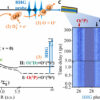Researchers from the University of Tsukuba have shown how adding a tiny resonator structure to an ultrafast electron pulse detector reduced the intensity of terahertz radiation required to characterize the pulse duration.
To study proteins—for example, when determining the mechanisms of their biological actions—researchers need to understand the motion of individual atoms within a sample. This is difficult not just because atoms are so tiny, but also because such rearrangements usually occur in picoseconds—that is, trillionths of a second.
One method to examine these systems is to excite them with an ultrafast blast of laser light, and then immediately probe them with a very short electron pulse. Based on the way the electrons scatter off the sample as a function of the delay time between the laser and electron pulses, researchers can obtain a great deal of information about the atomic dynamics. However, characterizing the initial electron pulse is difficult and requires complex setups or high-powered THz radiation.
Now, a team of researchers at the University of Tsukuba has used an optical resonator to enhance the electric field of a terahertz (THz) light pulse generated with a crystal, which reduces the required THz light to characterize the duration of the electron pulse. THz radiation refers to beams of light with wavelengths between those of infrared and microwave.
“Accurate characterization of the probe electron pulse is essential, because it lasts longer and is generally more difficult to control compared with the excitation laser beam that starts the atoms in motion,” explains co-author, Professor Yusuke Arashida.
Similar to how a room with the right acoustics can amplify the perception of sound, a resonator can enhance the amplitude of THz radiation with wavelengths that match its size and shape. In this case, the team used a butterfly-shaped resonator, that was previously designed by an independent research group, to concentrate the energy of the pulse. Through simulations, they found that the electric field enhancement was concentrated where the “head” and the “tail” of the butterfly would be.
They found that they could measure the electron pulse duration up to more than a picosecond using the THz streaking method. This approach uses incident light to spread out the electron pulse along a perpendicular direction. A “streak” in the camera is formed with time information now encoded into the spatial distribution of the resulting image.
“Ultrafast measurements using electron pulses can show the atomic-level structural dynamics of molecules or materials as they relax after being excited by a laser,” says senior author, Professor Masaki Hada.
Use of this resonator with a weak THz field and intensity of a few kV/cm was shown to be sufficient for characterizing electron pulses at picosecond timescales. This work may lead to a more efficient examination of atomic-level motions on very short time scales, potentially aiding in the study of biomolecules or industrial materials.
The paper is published in the journal ACS Photonics.
More information:
Wataru Yajima et al, Streaking of a Picosecond Electron Pulse with a Weak Terahertz Pulse, ACS Photonics (2022). DOI: 10.1021/acsphotonics.2c01304
Provided by
University of Tsukuba
Citation:
Optoelectronic resonator increases the sensitivity of an electron pulse detector (2022, December 15)



